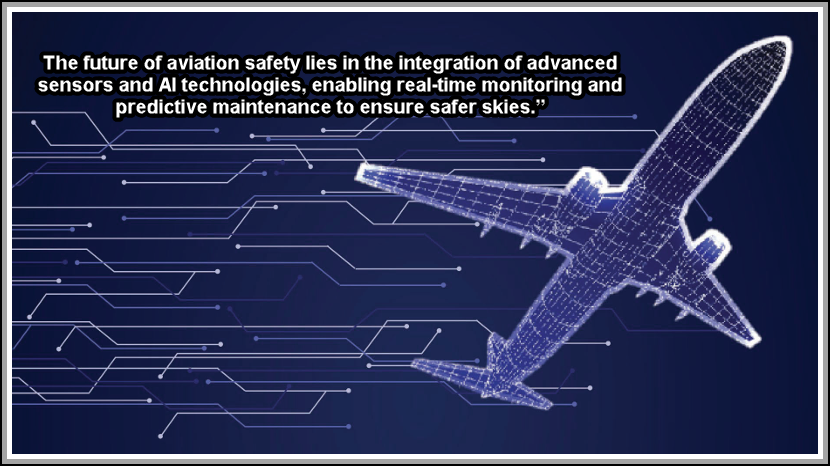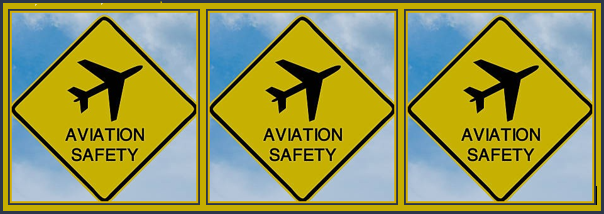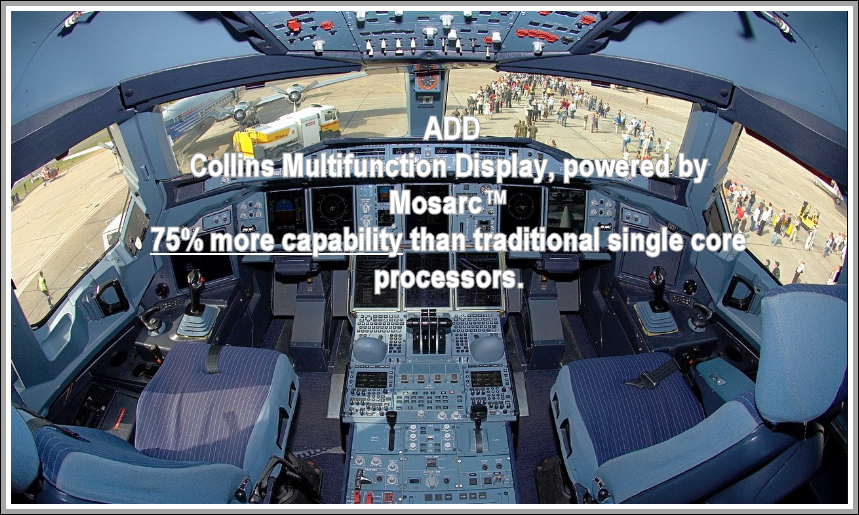RTX’s Mosarc™ adds computational capacity to add new Safety Sensors and Systems- y’all come!!!

An AVIATION SAVANT, when asked about how the industry’s safety performance can be improved, commented:
“The future of aviation safety lies in the integration of advanced sensors and AI technologies, enabling real-time monitoring and predictive maintenance to ensure safer skies.”
RTX, see below, has announced a significant enhancement in the capacity available to process data that is now and will become available to monitor the critical systems for flight.
Artificial Intelligence is the hottest technology in all industries. An article, AI IN AVIATION AND SAFETY, has prognosticated that aviation may see advancements in these specific examples:
Predictive Maintenance
Predictive maintenance is a crucial application of AI in aviation safety. By harnessing AI algorithms, airlines can proactively identify potential component failures and address them before they lead to critical issues. AI systems analyze data from sensors, aircraft systems, and historical maintenance records to detect patterns and indicators of potential failures. This data-driven approach enables airlines to predict maintenance requirements accurately and schedule proactive maintenance actions. The benefits of predictive maintenance are significant, including:
- Improved Reliability: By addressing maintenance needs before they escalate into failures, predictive maintenance ensures the reliability of aircraft systems. This reduces the likelihood of in-flight disruptions and unplanned maintenance, enhancing passenger safety and satisfaction.
- Cost Savings: Proactive maintenance allows airlines to avoid costly repairs caused by unexpected failures. By identifying issues in advance, airlines can plan and allocate resources efficiently, resulting in cost savings in both maintenance and operational areas.
Flight Operations
AI optimizes flight operations by providing valuable insights and decision-making support for pilots and dispatchers. The key applications of AI in flight operations include:
- Optimization of Flight Routes, Fuel Consumption, and Flight Plans: AI algorithms analyze real-time data, including weather conditions, air traffic congestion, and aircraft performance parameters, to optimize flight routes. By considering factors such as fuel efficiency, time constraints, and safety, AI systems generate optimal flight plans that reduce fuel consumption, emissions, and overall operational costs.
- Real-time Data Analysis and Decision-Making Support: AI systems process and analyze vast amounts of real-time data from various sources, such as weather reports, air traffic information, and aircraft sensor data. This analysis enables pilots and dispatchers to make informed decisions promptly. AI can provide recommendations regarding alternative routes, diversion options, or changes in flight plans to avoid hazards, optimize efficiency, and enhance safety.
Air Traffic Management
AI has a significant impact on air traffic management, ensuring efficient and safe operations. The applications of AI in this domain include:
Safety Analysis
AI is instrumental in ANALYZING VAST AMOUNTS OF DATA FROM DIVERSE SOURCES[1] to identify potential safety hazards and mitigate risks. Key aspects of AI applications in safety analysis include:
- Utilizing AI to Analyze Data for Hazard Identification: AI algorithms analyze data from flight recorders, maintenance records, pilot reports, weather data, and other relevant sources to identify patterns and trends that may indicate potential safety hazards. By processing and interpreting this data, AI systems can detect anomalies, deviations, or potential risks that might otherwise go unnoticed.
- Mitigating Risks through Pattern Recognition and Trend Analysis: AI’s ability to ANALYZE LARGE DATASETS1 FACILITATES THE IDENTIFICATION OF PATTERNS AND TRENDS RELATED TO SAFETY RISKS. By detecting patterns of incidents, near-misses, or operational errors, AI systems help aviation authorities and airlines develop targeted strategies and interventions to mitigate risks and enhance safety measures.
Pilot Training
AI plays a crucial role in pilot training, providing simulated scenarios for practicing emergency procedures and critical tasks. Key aspects of AI in pilot training include:
- AI-Based Simulation for Emergency Procedures and Critical Tasks: AI-powered simulators replicate real-world scenarios, allowing pilots to practice emergency procedures, decision-making under stress, and critical tasks in a safe and controlled environment. These simulations provide invaluable opportunities for pilots to refine their skills, improve their situational awareness, and develop the ability to handle challenging situations effectively.
- Skill Development and Preparedness for Challenging Situations: AI-based training tools provide personalized feedback and performance metrics to pilots, enabling them to track their progress, identify areas for improvement, and enhance their skills. By repeatedly practicing in realistic simulated environments, pilots gain experience and preparedness for various challenging scenarios they may encounter during actual flights.
Benefits and Impacts of AI on Aviation Safety
Enhanced Safety
The integration of AI in aviation safety brings numerous benefits that enhance the overall safety of the industry. The key impacts include:
- EARLY DETECTION AND PREVENTION OF POTENTIAL SAFETY HAZARDS: AI ALGORITHMS excel at analyzing vast amounts of data from various sources, enabling early detection of potential safety hazards. By identifying patterns, anomalies, and deviations in real-time data, AI systems can alert aviation authorities and airlines to take proactive measures. This early detection and prevention significantly reduce the risk of accidents, incidents, and safety-related incidents.
- Improved Decision-Making Based on Real-Time Data Analysis: AI enables real-time data analysis, allowing aviation professionals to make informed decisions promptly. By processing and interpreting complex data sets, AI systems provide valuable insights that aid in decision-making. Pilots, air traffic controllers, and maintenance personnel can leverage this real-time analysis to respond effectively to dynamic situations and ensure the safety of operations.
Increased Efficiency
AI not only enhances safety but also brings significant improvements in efficiency throughout the aviation industry. The impacts of AI on efficiency include:
- Optimization of Maintenance Processes and Resource Allocation: AI-driven predictive maintenance enables airlines to optimize maintenance processes by identifying and addressing issues before they cause failures. This proactive approach minimizes aircraft downtime, reduces the need for unscheduled maintenance, and maximizes aircraft availability. Additionally, AI algorithms assist in resource allocation, ensuring that maintenance personnel, spare parts, and tools are efficiently utilized.
- Improved Flight Operations and Air Traffic Management: AI optimizes flight operations by analyzing real-time data and providing recommendations for route optimization, fuel consumption, and flight plans. This optimization results in reduced fuel consumption, lower emissions, and overall cost savings for airlines. Similarly, AI enhances air traffic management by predicting and preventing congestion, delays, and disruptions. By efficiently managing air traffic flow, AI systems reduce delays, improve on-time performance, and enhance overall efficiency.
Cost Reduction
The integration of AI in aviation safety brings about cost reductions by minimizing in-flight disruptions, unplanned maintenance, and operational inefficiencies. The key impacts include:
- Minimized In-flight Disruptions and Unplanned Maintenance: Predictive maintenance powered by AI algorithms helps identify potential component failures before they occur. By addressing maintenance needs proactively, airlines can avoid costly in-flight disruptions, flight diversions, or cancellations caused by unexpected failures. This results in cost savings, improved reliability, and enhanced passenger satisfaction.
- Streamlined Operations and Reduced Delays: AI’s ability to analyze real-time data and provide decision-making support enables airlines to streamline their operations. By optimizing flight routes, fuel consumption, and flight plans, AI systems reduce delays, improve aircraft utilization, and enhance operational efficiency. This leads to cost savings and improved on-time performance for airlines.
The RTX success is a clarion INVITATION to ALL AVIATION SAFETY developers to design SENSORS and SYSTEMS that
- Identify potential hazards before failure
- Integrate the data from multiple on board instruments that collectively indicate, on an early basis, the emergence of potential risks– patterns, anomalies, and deviations– on real-time basis
- Secondary and/or tertiary data trends that signal crew awareness.
- Predictive Maintenance Sensors: These sensors monitor the health of aircraft components in real-time, predicting potential failures before they occur. Examples include:
- Vibration Sensors: Detect abnormal vibrations in engines and other critical components.
- Temperature Sensors: Monitor the temperature of various parts to prevent overheating.
- Structural Health Monitoring Sensors: These sensors continuously assess the structural integrity of the aircraft.
- Comparative Vacuum Monitoring (CVM) Sensors: Detect cracks and other structural damages.
- Piezoelectric Sensor Arrays: Monitor stress and strain on the aircraft’s structure.
- Environmental Sensors: These sensors provide data on environmental conditions both inside and outside the aircraft.
- Weather Sensors: Measure turbulence, wind shear, and icing conditions.
- Cabin Air Quality Sensors: Monitor the air quality within the cabin to ensure passenger comfort and safety.
- Flight Data Sensors: These sensors collect critical flight data to enhance situational awareness and decision-making.
- Air Data Sensors: Measure airspeed, altitude, and air temperature.
- Attitude and Heading Reference Systems (AHRS): Provide information on the aircraft’s orientation.
- Surveillance Sensors: These sensors help in tracking and monitoring aircraft positions.
- Multilateration (MLAT): Uses multiple ground stations to determine the aircraft’s position based on signal timing.
- Collision Avoidance Sensors: These sensors help prevent mid-air collisions.
- Synthetic Vision Systems (SVS): Provide a 3D view of the terrain and obstacles around the aircraft.

The FAA, as with the RTX Mosarc approval, will assess any proposal through the applicable regulatory processes. As with any new science or engineering proposal, this aviation safety organization will thoroughly scrutinize the details of a new sensor or system or whatever. Their AI Roadmap hints that new ideas may be well-received:
“Focus on Safety Assurance and Safety Enhancements: Center AI development in aviation on safety of AI and using AI for safety, targeting improvements in safety, and ensuring ethical considerations, particularly those that may affect safety, are addressed.”
This trend to use sensors, data and more powerful analytics can be traced to twenty years ago when Flight Operational Quality Assurance (FOQA) was established. That initial “building block” was the cornerstone to the current highly successful SMS which derives its power from meta data. Thus, a proposal to provide better, faster, more accurate, targeted numbers will likely get the FAA certification staff’s attention.
TC / STC / PMA / TSOA: Before manufacturing a product, an applicant must have a design approval: Type Certificate (TC), Supplemental Type Certificate (STC), amended TC, amended STC as well as a Production Certificate (PC) or other FAA production approval. JDA has the expertise and experience to support clients with TC, PC, STC, PMA or TSO authorization projects. We have Designated Engineering Representatives (DERS) Designated Airworthiness Representatives (DARs) and former FAA MIDO staff that can manage and facilitate your project.



RTX’s Collins Aerospace receives first-ever FAA approval to increase cockpit processing power
September 18, 2024
Collins’ Display with Mosarc increases cockpit processing power by 75% and decreases certification risk
CEDAR RAPIDS, Iowa, Sept. 18, 2024 /PRNewswire/ — Collins Aerospace, an RTX (NYSE: RTX) business, received the first-ever FAA TECHNICAL STANDARD ORDER (TSO) approval for a fully enabled multi-core processor. The Collins Multifunction Display, powered by Mosarc™, will increase the speed, CAPACITY AND FLEXIBILITY OF AN AIRCRAFT’S FLIGHT DECK, PROVIDING 75% MORE CAPABILITY THAN TRADITIONAL SINGLE CORE PROCESSORS.

With this authorization, the Multifunction Display is now the world’s first multi-core processor that’s certified for civil and military aircraft and facilitates simultaneous use of all processing cores across all Design Assurance Level (DAL) standards. This certification paves the way to utilize the processor for future hardware to enable multi-core processing.
“On a military mission, every second counts and access to information is critical,” said Dave Schreck, vice president and general manager of Military Avionics and Helicopters at Collins Aerospace. “Collins’ display is the only multi-core processor on the market that is certified by the FAA and is being used by the U.S. Army. This translates to being much more efficient in integrating new capabilities while also being able to safely run more applications in parallel than ever before.”
This enhanced performance comes from the system’s ability to PROCESS DATA 12 TIMES FASTER THAN A SINGLE CORE PROCESSOR, CONSUMING 40% LESS POWER. It integrates multiple operating systems, which enables rapid third-party integration and reduces vendor lock. Ultimately, this provides platforms the flexibility to integrate evolving mission-systems capabilities in weeks rather than recertifying flight critical applications every time, which can take months or longer.
Collins has been a leading provider of civil-certified, high integrity, safety-critical processors for military aircraft for more than two decades. To date, the display has completed more than 6,000 hours of flight tests and is optimized for use in rotary-wing, fighter, bomber and trainer environments.
About Collins Aerospace
Collins Aerospace, an RTX business, is a leader in integrated and intelligent solutions for the global aerospace and defense industry. Our 80,000 employees are dedicated to delivering future-focused technologies to advance sustainable and connected aviation, passenger safety and comfort, mission success, space exploration, and more.
About RTX
With more than 185,000 global employees, RTX pushes the limits of technology and science to redefine how we connect and protect our world. Through industry-leading businesses – Collins Aerospace, Pratt & Whitney, and Raytheon – we are advancing aviation, engineering integrated defense systems, and developing next-generation technology solutions and manufacturing to help global customers address their most critical challenges. The company, with 2023 sales of $69 billion, is headquartered in Arlington, Virginia.

[1] That is added capacity that the Multifunction Display, powered by Mosarc™, SEE BELOW.
